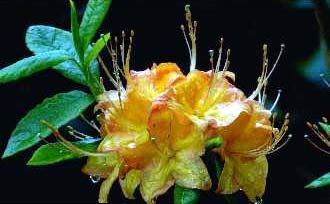When space is at a premium, a container garden allows you to fashion a small environment ideal for special plants. It also creates visual focus and excitement for terrace, patio, or garden.
There are many exciting possibilities for gardening in containers, from a simple earthenware bowl brimming with brightly colored summer annuals to elaborate stone troughs arranged with miniature evergreens and alpine ornamentals.
A World Apart
Often limitations of space or soil type prevent you from growing certain plants in your garden. The most common example is rock garden plants. These beautiful alpine natives are very particular about both soil and watering methods. The typical garden is rarely suitable; yet it is possible to create, in the limited space of a container, a perfect environment for such special plants.
Advantages of Small Gardens
In addition to giving you greater control over soil and watering, container gardens offer other advantages. The smaller scale of a container garden means less work for you and more attention for sensitive plants. The subtle forms of miniature foliage and flowers can easily be lost in a larger garden, but come into beautiful focus in containers.
Container Materials
Half of the beauty of container gardens is shaped by the containers themselves. There are many suitable materials. Keep in mind the plants you will be growing and choose materials that will harmonize with them. A stone trough or a small raised bed made from individual stones are both attractive. Nurseries often sell concrete aggregate troughs and containers especially for miniature rock gardens.
Wood containers are lighter and less expensive than stone. And they are just as attractive if chosen carefully. The best wooden containers for rock gardens are sturdy and rustic in appearance. A barrel half, usually made of oak, is a perfect container. Boxes or tubs of rough-cut wood are also suitable. Unless the wood is naturally rot-resistant (redwood or cedar, for instance), you will need to coat the inside of the container with a wood preservative that is nontoxic to plants. After placing in the garden, elevate it with bricks or concrete blocks to keep the bottom of the container from rotting.
Placing the Container
Container gardens are attractive on a terrace or along a garden path. Most plants do well with morning sun only – full sun all day is more than they can stand. If you place the container on a terrace or other finished surface, make sure that there is sufficient clearance under the container to allow water to drain out. Situate the container garden so that natural drainage will flow away from traveled areas.
Preparing the Soil
Container gardens give you enormous freedom in determining the soil type. You can create a special soil mix, for instance, for lime-loving rock plants. Most rock garden plants like coarse soil that drains very rapidly. A mixture of one part each fine gravel, river sand, and leaf mold or peat moss is common. The container should be fertilized once a year in spring with a top dressing of compost or very well-rotted manure.
Container Plants
There are literally hundreds of plants suitable for container gardens. Two things to keep in mind: when selecting shrubs, be sure to pick slow-growing, dwarf varieties; and if you plant ground covers, choose varieties that will not rapidly overwhelm their neighbors. Some good choices include dwarf heather, houseleek, stonecrop, miniature primroses, small blue gentians, and small succulent varieties.
IMPORTANT
The container garden will require little work if you start with sterilized, weed-free soil. After filling a new container or trough with soil, water it thoroughly and let the soil settle for a few days before planting. Flowers and vegetables make ideal garden companions.
TIPS: GARDEN TROUGHS
A trough is one of the most popular containers for miniature gardens. Limestone troughs are common, but these are only suitable for lime-loving plants. For other garden plants, choose a trough made from sandstone or granite.
STEPS FOR SUCCESSFUL PLANTING IN CONTAINERS
A carefully planned container garden will give you great pleasure with very little work. Follow these simple steps to establish a thriving miniature garden.
1. Before planting, clean the container well with a wire brush. If it has been used for plants before, scrub it with water with some bleach added to kill any disease organisms that might linger. Then let the container dry thoroughly in the sun.
2. Cover drainage holes with galvanized wire mesh to keep the soil from washing out. Fill with a layer of coarse gravel; a layer of fine gravel or coarse peat moss; a thin layer of sphagnum moss; and finally, fill the container with a soil mixture of equal parts fine gravel, river sand, and peat moss or leaf mold. Water and allow to settle before planting.
3. Begin planting with shrubs. Then add a few decorative rocks or pieces of wood to complete the composition.
4. Now fill in with smaller plants. You may, of course, choose to leave some areas unplanted. Cover these with fine gravel.
5. The finished container garden needs periodic watering, but little other care.
6. In cold climates, cover the container garden with a light mulch of peat moss, leaves, or pine needles to protect sensitive plants from freezing.


